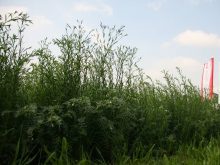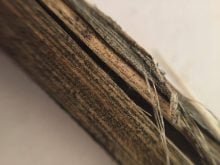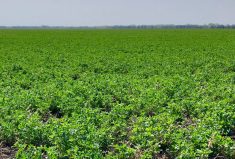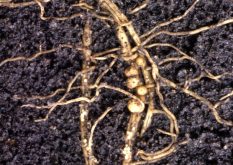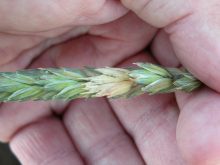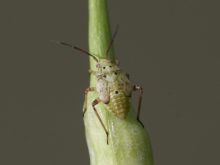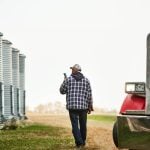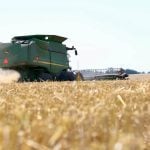Western Canadian canola, corn and soybean growers will have valuable new crop protection tools for the 2023 growing season, as Corteva Agriscience introduces new packages of seed treatment products that control a range of crop pests.
Known as the LumiGEN seed treatment packages — each tailored for canola, corn and soybeans — the idea is to bring together both old and new chemistries in these packages to control both insects and diseases that attack newly germinated crops at the seedling stage.
“The LumiGEN product contains the entire recipe of seed treatment products for exclusive use with Pioneer and Brevant canola, corn and soybean varieties,” says Kirsten Ratzlaff, product manager for seed applied technology at Corteva Agriscience.
Read Also

Claas brings 1000 Series SP forage harvesters to Canada
In mid-August, Claas unveiled its new line of Jaguar forage harvesters at an event in Visalia, California, deep in the heart of that state’s dairy region.
The LumiGEN package for canola includes Lumiderm, a well-established Corteva product that provides protection against flea beetles and cutworms, along with a new fungicide package known as Lumiscend.
“Lumiscend is an entirely new fungicide seed treatment package,” says Ratzlaff. “It contains four new fungicide active ingredients that provide multiple modes of action and is really a step up in the level of disease protection.”
Blackleg protection
Ratzlaff says Lumiscend provides an improved level of control against diseases such as seedling disease complex, rhizoctonia and pythium. “And we are really excited to offer a unique, new active ingredient for protection against airborne blackleg disease in canola.”
Corteva’s announcement about a fungicide offering improved protection against blackleg comes at a time of recent news from Agriculture and Agri-Food Canada about progress being made in unravelling the genetic code of the blackleg pathogen. Breaking the code will help plant breeders develop new canola varieties with improved blackleg resistance.
Blackleg has become a widespread and devastating disease in canola, particularly in the past dozen years. Estimates indicate approximately 55 per cent of western Canadian canola acres are affected by blackleg, which has been estimated to account for an average yield loss of 9.67 per cent. In more severe infections, yield losses can range up to 50 per cent.
While developing varieties with improved disease resistance is one important tool for reducing yield losses, producers are urged to apply a multi-pronged management approach including seed treatments for the widest possible disease protection. More on the latest research and best management practices follows.
Improved production
Dozens of field trials with the key products included in the LumiGEN package for canola have shown improved plant stands as well as improved canola yields. Demonstration trials with Lumiderm insecticide seed treatments have shown an average increase of 1.4 bushels of canola per acre and as much as a 35 per cent reduction in flea beetle damage.
Field trials with Lumiscend-treated canola seed show an increase of five to six more canola plants per square metre compared with plots of canola treated with other fungicide products.
“Lumiscend translocates through seedlings to inhibit the growth of the blackleg fungus, protecting the crop from emergence through the critical infection period,” says Ratzlaff.

With the LumiGEN corn package, producers can expect a similar combination of effective crop protection products, she says. The corn package includes Lumivia, a broad spectrum insecticide seed treatment for early season protection against key corn pests.
It also contains Lumiscend Pro, which, like the canola package, is also a unique combination of four active ingredients for long-lasting seed- and soil-borne disease protection against pythium, rhizoctonia, fusarium and corn head smut.
As well, the corn package includes Lumialza, a biological nematicide seed treatment product that helps protect corn roots for more than 80 days against a wide range of nematodes, including sting, needle, lance, stubby-root, root-knot, dagger and lesion.
“Although nematodes are impossible to detect with the naked eye, they can have a devastating effect on yield,” says Ratzlaff.
The LumiGEN soybean package includes Lumisena, a fungicide seed treatment protecting soybeans against phytophthora, as well as Lumiderm insecticides, providing broad spectrum protection from early season insect pests.
More on blackleg research
First detected in a Saskatchewan crop in 1975, blackleg — with its ever-increasing number of different strains — has spread across the Prairies. Made worse in recent years by tightened canola rotations, which allows the disease inoculum (Leptosphaeria maculans) to build up in the soil, severity can range up to as much as 50 per cent yield loss in affected crops.
Recently, Agriculture and Agri-Food Canada (AAFC) researchers achieved a major milestone in getting a leg up on blackleg by gaining a much clearer picture of the unique strains of blackleg disease found in Canada.
Led by AAFC biology study leader (plant pathology) Fengqun Yu, a team of Saskatoon-based scientists recently completed the first large-scale resequencing of the blackleg pathogen in the world. They have used this resequencing to get an accurate view of Canadian populations of blackleg causing L. maculans.
Knowledge of the pathogen’s genetic variability and population structure, which can be measured using molecular markers, is key. Armed with this knowledge, researchers will be able to develop new strategies for better crop protection and improved blackleg resistance in Canadian canola crops.

A clearer picture of blackleg
Canadian strains have been previously characterized by relatively few molecular markers, which has made it difficult to detect the variation responsible for the pathogen’s ability to adapt. However, with the cost of DNA sequencing rapidly dropping, Yu’s team was able to select 162 strains taken from Western Canada in two separate decades. This allowed the team to get a much clearer view of Canadian populations than ever before.
“In a diversified population, the pathogens have many different genetic backgrounds, giving the disease greater ability to change, adapt and potentially take hold of a crop,” says Yu. “This ability to adapt makes it harder to control the disease, so a better understanding of pathogen genetics is key to helping growers protect their crops.”
The ultimate goal of understanding L. maculans is to improve crop protection measures. For example, it will provide crop breeders with information they can use when developing new canola cultivars with increased blackleg resistance.

Best management practices
While crop resistance is important, it is recommended producers follow an integrated management strategy. Recommendations from the Canola Council of Canada, particularly if the previous canola crop was infected severely with blackleg, is to follow a multi-pronged management approached.
Best management practices should include the following:
- Extend canola rotations. Tightened canola rotations allow for blackleg inoculum to build up within a field. Extending canola rotations (greater than a two-year break from canola) will allow more time for inoculum levels to decline as old canola stubble decomposes.
- Scout for disease. Look for internal stem blackening at ground level during swathing or straight cutting, or signs of the disease on stubble from the previous crop.
- Use resistant varieties. Plant either “resistant” (R) or “moderately resistant” (MR) cultivars. Resistant cultivars outperform susceptible or bin-run seed.
- Rotate resistance sources. Rotate cultivars by their major blackleg resistance gene. Similar to herbicide group rotation, rotating blackleg major resistance genes will slow the L. maculans races from becoming resistant toward these genes. Use a L. maculans race identification test to determine predominant L. maculans races in a field to help match appropriate resistance sources.
- Use a fungicide seed treatment product, which protects plants from blackleg when they are most susceptible. An early season foliar fungicide application can help prevent yield losses if applied during the cotyledon to two-leaf stage. Later foliar applications can help to reduce the inoculum in the field.




